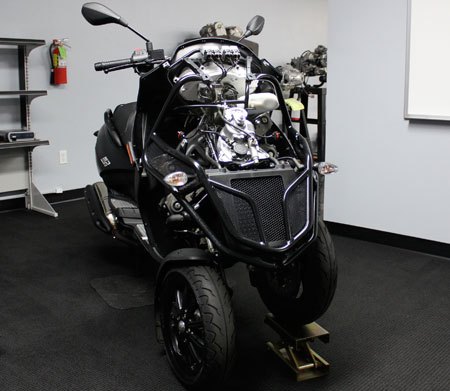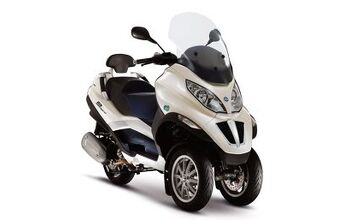Piaggio's CEO Speaks Out on State of Motorcycling
It was with passion and personal conviction that Piaggio’s President and CEO, Paolo Timoni, issued a challenge and appeal to the motorcycle industry in general, and the powersports media in particular.
As the leader for Piaggio Group Americas, Inc., manufacturer of Vespa, Piaggio Moto Guzzi, and Aprilia products, Timoni spoke at Piaggio’s facility in Costa Mesa, Calif. on May 18, ostensibly to offer a routine annual talk about his company and its products.
In doing so, he issued a wake-up call, one he said he’s been repeating for some time now to the journalists present, but which seems to be falling on deaf ears.
Specifically, if the motorcycle industry wants to grow again, Timoni – who also serves as a board member on the Motorcycle Industry Council (MIC) – said it will have to become a lot more focused in attracting younger people to riding, and recruiting non-riding commuters to the prospect of embracing two-wheel transport.
While his appeal targeted journalists at this meeting – who he said should be doing more writing about the benefits of two-wheeled transport – his message could just as well have been to all people concerned in the motorcycle industry.
According to the MIC, North American motorcycle and scooter sales have been cut in half since 2006 saw 1,190,000 units sold, compared to 627,000 in 2009. Timoni's comment on this state of affairs is that in addition to causes from the withered stock and housing markets, and other factors, the industry also has itself to blame.
“Aging Baby Boomers” have been the powersports’ industry core customer base, he said, and the fortunes of the industry have therefore risen and fallen largely on the net wealth of this large but limited demographic.
“It shouldn’t be anyone’s surprise that relatively poorer baby boomers have less money to spend on desirable toys,” Timoni said, “And this is exactly what happened.”
Coming outside of a “comfort zone” will be needed, Timoni said, to revamp an industry that has had to cut jobs and spending, and is no longer as secure for many people who have long known and loved motorcycling.
Timoni also offered hope and optimism, however, as he said sales look like they are stabilizing and beginning to rebound this season. He also described how his company is meeting challenges while holding on in the U.S.
“I think a very fair and reasonable question is, ‘Okay, what is going to happen with Piaggio Group America?’” he said.
His company is a small player, he said, so “a reasonable question is Piaggio Group North America going to exit the North American market?”
Timoni answered his rhetorical statement.
“The very good news here is that we are not going anywhere, and this is not just because we are good guys,” he said, “but it is somehow because we have restructured our business in a way that will allow us to face and handle the situation.”
More to the point, Timoni said, his company has cut expenditures and slashed its U.S. payroll by 20 percent, reducing from around 75 employees to around 60. Further, Piaggio has renegotiated lower costs from vendors and suppliers, and most important of all, it has always been globally diversified.
In essence, strong markets, especially in Asia, are now bolstering the flagging North American and European markets.
“We never developed an organization that was only focused on the U.S. market,” Timoni said.
Or, as Timoni described it in a private interview with Motorcycle.com prior to the meeting, all of Piaggio’s products are world products, not targeted – or dependent on – any one geographic market. This, it was asserted, plus its small size and R&D approach give the company significant advantages over its competition.
“I think we can combine the scale and global presence of the larger Japanese players, and all the benefits and the strengths that come from having the scale and global presence, with distinctive design and product development which is typical more of the smaller player like Ducati, or Triumph or KTM,” Timoni said, “So we are the unique and best combination of both worlds.”
Timoni said India and Vietnam’s markets are particularly doing well. A new plant was opened recently in Vietnam, and small economical vehicles are being produced there for the hungry growing markets that recognize their utility as transportation.
Meanwhile in the U.S., Timoni said a network of around 400 dealers offer strong support. Gone are the dark days of 2005-2006 when Aprilia and Guzzi struggled achieving adequate parts supply due to financial difficulties. Rick Panettieri, Aprilia/Guzzi brand manager, told us the company’s fill rate is now at 98 percent within two weeks.
Timoni added he is committed to opening a “national discussion” on the viability of lightweight powersports vehicles as basic transportation.
On that note, he concedes that people have been asking when the MP3 Hybrid would be available. Last summer the company announced a 124cc hybrid gas/electric vehicle offering 141 mpg would be launched in first quarter 2010.
That vehicle is now a 300cc gas/electric product, and is selling in Europe – and Timoni said with no problems, such as plagued the intro of the RSV4.
The federal government has delayed Piaggio’s MP3 plans, however.
“Its going to be finally here in Q4 this year,” Timoni said, “We had issues homologating the product with the EPA because in the U.S. it is the first plug-in vehicle.”
Basically, they had to sit down with the EPA and help write the rulebook, he said.
The cost of the now-300cc vehicle was not disclosed, and it will get about 100 mpg, compared to about 65 mpg from a 250cc gas-only MP3. It is expected to be a “niche” product because it will cost more having both an electric and gasoline powerplant. But, said Timoni, “It will kick the ass of the Prius!”
Further, the three wheeled MP3 – with enough room on board to place the large motor – is the only vehicle Piaggio foresees making as a hybrid.
“Two engines take all the space,” he said, and the design of regular scooters or motorcycles would not be as accommodating.
Piaggio also offers a range of scooters now, as well as its CVT-transmission Aprilia Mana GT and other models for commuters. The company is therefore putting its money where its mouth is and advocates non-riding commuters need to be converted to the powersports fold.
Things won’t automatically go back to the way they were before, however, and Timoni said that every player in the industry – not least of which including the media who he was addressing – need to do what they can, because new blood in the world of motorcycling is definitely needed.
So, we’d like to know what you think is needed to get more people into motorcycling. What is stopping more American consumers from embracing inexpensive, high-mpg vehicles?
We think it has to do in part with a PR problem among the non-riding public, including perceived concerns for safety, year-round convenience in some regions, and more.
We agree with Timoni that more can be done, and we are open to new approaches to expanding the appeal of motorcycling. What are your ideas?
Let’s keep this subject rolling in the Reader Feedback link below.
Related Reading
2009 Piaggio BV500 Scooter Review
2008 Piaggio MP3 500 i.e. Review
2010 Literbike Shootout: Aprilia RSV4 Factory vs. Ducati 1198S vs. KTM RC8R
2010 Literbike Shootout: RSV4 R vs S1000RR vs CBR1000RR vs ZX-10R
Aprilia Mana 850GT Introduction [video]
More by Jeff Cobb






























Comments
Join the conversation